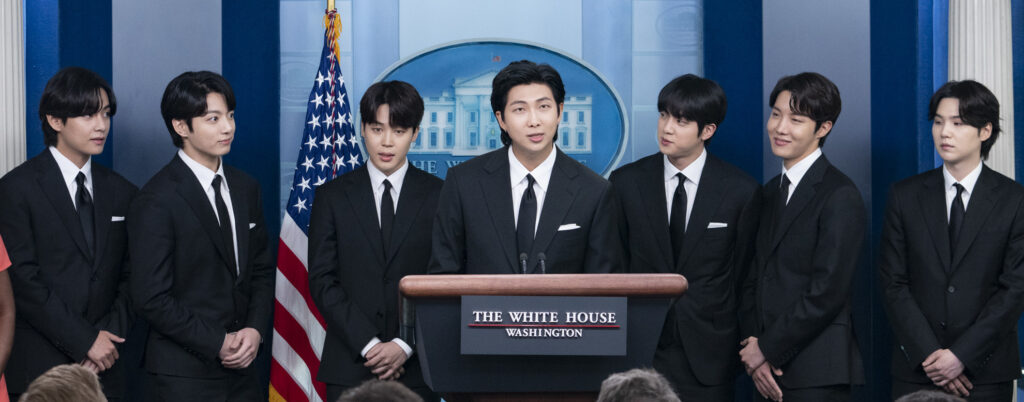The Powerful BTS Logo From K-Pop To Global No.1

BTS is one of the most recognizable names in K-pop. Originating from South Korea, BTS has created a musical revolution, surpassing borders to become a global cultural phenomenon. They have redefined K-Pop and reshaped the dynamics of the music industry at large. In addition to their vocal and dance prowess, the BTS logo symbolizes the band’s identity and meteoric rise.
In today’s post, we will shed some light on the story behind the BTS logo, delving into its creation, evolution, and profound symbolism. We will explore how the BTS logo became a part of their identity. Also preparing FAQs that you may be interested in, such as who is the leader of bts. Let’s get started.

The Rise of BTS
BTS, as known as “Bangtan Boys” emerged as a leader in the world of K-Pop. Big Hit Entertainment formed this South Korean boy band in 2013 and quickly gained attention for their musical talent, dynamic choreography, and engaging performances. The group consists of seven members: RM, Jin, Suga, J-Hope, Jimin, V, and Jungkook, each bringing their style and personality to the group.
BTS’s incredible rise is a testament to their dedication, resilience, and undeniable talent. Even though they faced challenges, they never wavered in their pursuit of musical excellence. Their ability to tackle diverse topics in their music, such as global issues and mental health, earned them a loyal fanbase known as the “ARMY.”
BTS expanded their influence with chart-topping albums, record-breaking performances, and numerous awards. They shaped fashion trends, participated in philanthropy, and represented South Korea internationally. Their journey from humble beginnings to global prominence captivates fans and music enthusiasts.
The Birth of the BTS Logo

The story of the BTS logo began with the group’s inception. As BTS embarked on their music industry journey, creating an identity beyond their talents became essential. They needed a symbol that embodied their values, vision, and unity to resonate with their growing fan base. The BTS logo not only represents the essence of BTS but also serves as a rallying point for their fans worldwide.
The BTS logo was first designed based on the group’s Korean name, “Bangtan Sonyeondan,” which translates to “Bulletproof Boy Scouts.” Featuring bulletproof vests, the band’s logo signifies their commitment to deflecting negativity and social expectations through their music and message. The initial design was the foundation for the symbol synonymous with BTS and their remarkable journey.
The Evaluation of the BTS Logo
Over the years, the BTS logo has evolved to reflect the group’s growth, artistic evolution, and global influence. During its early development, the logo symbolized the essence of “Bulletproof Boy Scouts,” but it has undergone several changes to represent the group’s evolving image.
At first, the logo featured bulletproof vests and bullet holes, symbolizing protection and resilience against life’s challenges. As BTS became more popular internationally, their logo evolved as well. With its bold, sleek design and interconnected letters, the modern BTS logo represents unity and harmony among the members and their fans.
The BTS logo changed to reflect the group’s visual identity and their journey from a rising K-Pop sensation to a global phenomenon. It’s a visual testament to their growth, adaptability, and enduring spirit.
Symbolism and Meaning of the BTS Logo

BTS, the remarkable sensation of the K-pop world, has transcended borders to become a global icon. Their logo, which has become a symbol of limitless success, holds a special place in the hearts of fans around the world. The catchphrase “Borahae” aka “I Purple You”, often used by BTS member V, is closely associated with this iconic emblem. “Borahae, which translates to “I purple you” in Korean, is a sentimental expression that has become inseparable from the group and their loyal ARMY fanbase. The color purple embodies the unwavering support and affection between BTS and their fans. Infused with these heartfelt messages, the BTS logo reflects their journey from K-pop sensations to global superstars, underscoring the profound impact they’ve had on their fans and their unwavering status as global icons.
BTS Logo’s Impact on Branding
BTS logo plays an integral role in the group’s branding strategy and contributes to BTS’ global success and recognition.
In addition to representing the group, the logo shapes BTS’s brand identity and influences its branding efforts.
1. Distinctive Brand Recognition

The BTS logo’s unique design sets it apart in a crowded entertainment landscape. Its bold, interconnected letters make for a memorable and easily recognizable symbol, creating a solid image in the minds of fans and the general audience alike.
2. Versatile Brand Application
The logo’s sleek and modern design allows for versatile applications. The BTS logo seamlessly integrates across all branding materials, from album covers and merchandise to social media profiles and concert visuals, ensuring a cohesive and consistent brand image.
3. Emotional Connection
Besides representing BTS, the BTS logo represents shared experiences and emotional connections among the ARMY. It strengthens the emotional bond between fans and the band by instilling a sense of belonging.
4. Global Market Penetration
The BTS logo has played a vital role in BTS’s global expansion. Aside from its visual appeal, the group’s symbolism resonates across cultures, making it popular across many markets.
5. Merchandising and Revenue Generation

The logo is prominently featured on numerous products, generating significant revenue for the group. It is a significant sales driver for clothing and accessories branded with the logo.
In addition to effectively representing the group’s identity, the BTS logo also contributed to the group’s global recognition and commercial success.
BTS and Global Dominance
Originally a K-Pop group, BTS has gone beyond borders to become a global phenomenon. Their incredible talent, hard work, and deep connection with their fans, known as the ARMY, have led them from South Korea to the international stage.
1. Worldwide Chart-Toppers

In addition to South Korea, BTS has been topping charts in numerous countries around the world, including the United States, United Kingdom, Japan, and more. Their albums consistently break records and achieve multi-platinum status.
2. Sold-Out World Tours
BTS’s performances are in high demand. Their world tours sell out within minutes, filling stadiums and arenas around the globe. With their electrifying live performances, the group demonstrates the fervor of their worldwide fan base.
3. Global Philanthropic Initiatives
Besides music, BTS engages in philanthropic activities. They have positively impacted communities worldwide by supporting causes such as education, mental health, and children’s welfare. Their influence transcends the entertainment industry and inspires positive change.
4. Cultural Icon Status

BTS has achieved cultural icon status, influencing music, fashion, art, and societal discourse. Their influence on pop culture is undeniable, making them recognizable figures on the global stage.
Watch “Permission to Dance” performed at the United Nations General Assembly
5. Multinational Collaborations
BTS’s collaborations with international artists and brands further exemplify their global reach. Collaborations with renowned artists and entities showcase their versatility and acceptance on the world stage, promoting cultural exchange and understanding.
BTS’s global dominance is a remarkable tale of talent, authenticity, and connection. With their ability to resonate with audiences worldwide, they’ve cemented themselves as true global icons.
FAQs
Why did BTS change their logo?
BTS changed its logo in 2017 to align with the evolving concept and ideology behind the band’s name. The transformation from “Bulletproof Scouts” to “Behind the Stage” was a pivotal moment that marked a significant shift in the group’s philosophy and direction. Their changes in perspective lead to changes in graphical composition, symbolic of their growth, progress, and desire to learn more about their art. The new logo represents their journey towards transparency, authenticity, and deeper audience connections.
Watch the BTS LOGO ANIMATION video
What is the official logo of BTS?
The official logo of BTS, also known as the BTS badge, is a minimalistic geometric emblem. It features two mirrored trapezoids, white with a blue-laced face-to-face arrangement, with narrow sides meeting in the middle. This design resembles a shield and symbolizes the band’s name, initially called the “Bulletproof Scouts.”
In addition to the symbol, the logo incorporates simple yet stable uppercase sans-serif lettering placed under the emblem, spelling out “BTS.” This combination of the symbol and typography constitutes the recognized and official logo representing BTS, the globally renowned K-pop group.
How does the BTS logo resonate with the ARMY (fans)?
The BTS logo holds sentimental value for the ARMY, representing the group and fellow fans’ shared journey and experiences. It fosters a sense of belonging and unity among the ARMY, reinforcing the emotional connection with BTS. The logo acts as a unifying symbol expressing pride and love for the group, strengthening the bond within the global fanbase.
How many songs does BTS have?
Here’s not only how many songs does BTS have, but which ones are the most popular. Throughout their career, BTS have released numerous songs across a wide range of albums, such as studio albums, mini-albums and singles. The total number of songs they have released may vary due to different versions, collaborations, and solo projects by individual members. As of September 2023, they have released over 200 songs. It’s important to note that their ongoing musical projects may have caused this number to increase since then. Their most popular songs include “Dynamite”, “Boy With Luv”, “Life Goes On”, “Blood Sweat & Tears” and “MIC Drop”. Among these, “Dynamite” was a turning point for BTS as it became their first track to top the Billboard Hot 100 chart and gained immense popularity worldwide.
Who is the leader of BTS?
RM, also known as Kim Nam-joon, was born on September 12, 1994. He is the respected leader of the internationally acclaimed K-Pop group, BTS. His leadership role extends beyond a mere title; it attests to his exceptional talent in guiding and motivating his fellow members, managing their diverse personalities, and ensuring the group’s continued success and unity.
Known by his stage name RM, which stands for ‘Rap Monster,’ he is renowned not only for his remarkable rapping skills but also for his insightful songwriting and meaningful messages. A proficient English speaker, RM frequently serves as BTS’s representative at global events, earning admiration and respect from fans and colleagues alike for his intelligence, modesty, and persistence.
Over the years, RM’s leadership has played a crucial role in shaping BTS’s distinct identity and musical style. Despite leading a prominent group under immense pressure, he displays unwavering dedication, strength, and resilience. RM’s leadership, along with the collective talent of the group, has been crucial in propelling BTS to global fame.
The Takeaway
In the symphony of K-Pop, BTS has composed a resounding note, transcending boundaries and making an indelible mark as a global icon. Their logo represents their journey from bulletproof Boy Scouts to a harmonious powerhouse, symbolizing unity and innovation. Its evolution reflects their growth, resilience, and enduring spirit.
The BTS logo continues to inspire fans with its message of unity and inspiration, echoing their belief in the power of music. BTS isn’t just a musical sensation but a testament to the universal language of passion and unity.
